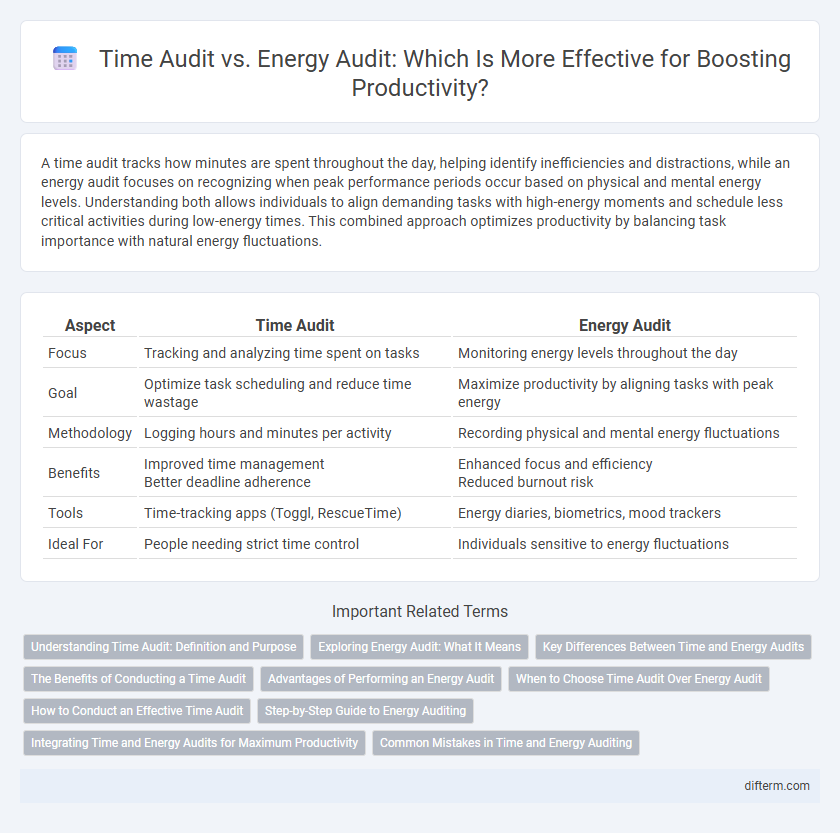A time audit tracks how minutes are spent throughout the day, helping identify inefficiencies and distractions, while an energy audit focuses on recognizing when peak performance periods occur based on physical and mental energy levels. Understanding both allows individuals to align demanding tasks with high-energy moments and schedule less critical activities during low-energy times. This combined approach optimizes productivity by balancing task importance with natural energy fluctuations.
Table of Comparison
| Aspect | Time Audit | Energy Audit |
|---|---|---|
| Focus | Tracking and analyzing time spent on tasks | Monitoring energy levels throughout the day |
| Goal | Optimize task scheduling and reduce time wastage | Maximize productivity by aligning tasks with peak energy |
| Methodology | Logging hours and minutes per activity | Recording physical and mental energy fluctuations |
| Benefits | Improved time management Better deadline adherence |
Enhanced focus and efficiency Reduced burnout risk |
| Tools | Time-tracking apps (Toggl, RescueTime) | Energy diaries, biometrics, mood trackers |
| Ideal For | People needing strict time control | Individuals sensitive to energy fluctuations |
Understanding Time Audit: Definition and Purpose
A time audit is a systematic process of tracking and analyzing how time is spent throughout the day to identify inefficiencies and areas for improvement. This method helps individuals and organizations gain insight into daily activities, enabling better prioritization and allocation of time resources. Understanding the purpose of a time audit allows for increased productivity by highlighting time-wasting habits and fostering more intentional scheduling.
Exploring Energy Audit: What It Means
Energy audit involves analyzing daily activities to identify moments of high and low physical and mental energy, optimizing productivity by aligning tasks with peak energy periods. Unlike time audits that track time allocation, energy audits emphasize personal energy rhythms to improve focus, reduce burnout, and enhance overall efficiency. Understanding energy patterns helps tailor work schedules to individual strengths, leading to sustainable productivity gains.
Key Differences Between Time and Energy Audits
Time audits analyze how hours are allocated across tasks to identify time-wasting activities and improve scheduling efficiency. Energy audits focus on tracking physical and mental energy levels throughout the day to optimize productivity during peak performance periods. The key difference lies in time audits emphasizing task duration, while energy audits prioritize alignment of work with natural energy rhythms for sustained focus.
The Benefits of Conducting a Time Audit
Conducting a time audit enhances productivity by revealing precise patterns of task allocation and identifying periods of inefficiency. This detailed analysis enables individuals to prioritize high-impact activities, reduce procrastination, and optimize work schedules based on peak concentration times. Time audits also facilitate setting realistic goals and improving overall time management strategies, leading to increased output and reduced stress.
Advantages of Performing an Energy Audit
Performing an energy audit identifies periods of peak mental and physical performance, enabling more effective task scheduling compared to time audits that only track hours spent. Energy audits optimize productivity by aligning work demands with natural energy fluctuations, reducing burnout and enhancing focus. This approach leads to improved efficiency and sustained motivation throughout the workday.
When to Choose Time Audit Over Energy Audit
Choose a time audit over an energy audit when precise tracking of task durations and identifying time-wasting activities is crucial for enhancing productivity. Time audits excel in uncovering inefficiencies in scheduling, enabling targeted adjustments to work routines and deadlines. This method benefits professionals managing multiple deadlines or seeking to optimize time allocation for complex projects.
How to Conduct an Effective Time Audit
Conducting an effective time audit involves tracking daily activities in detail for at least one week to identify patterns of productivity and time-wasting habits. Use tools like timers, journals, or digital apps to log start and end times of tasks, categorizing them by priority and energy levels required. Review the collected data to allocate time more efficiently, eliminate distractions, and align tasks with peak energy periods for maximum productivity.
Step-by-Step Guide to Energy Auditing
A step-by-step guide to energy auditing begins with tracking when energy levels peak and dip throughout the day, contrasting with traditional time audits that only record hours spent on tasks. It involves identifying tasks that require high concentration or physical stamina and aligning them with these energy peaks for maximum efficiency. Regular energy audits help optimize productivity by tailoring work schedules to natural body rhythms rather than fixed time blocks.
Integrating Time and Energy Audits for Maximum Productivity
Integrating time and energy audits enhances productivity by identifying not only how minutes are spent but also when peak energy levels occur, allowing for task scheduling that aligns with natural productivity cycles. Time audits provide detailed logs of activities, while energy audits reveal patterns of mental and physical stamina throughout the day, enabling a comprehensive approach to work optimization. This combined strategy reduces burnout, maximizes focus during high-energy periods, and ensures efficient use of both time and effort.
Common Mistakes in Time and Energy Auditing
Common mistakes in time and energy auditing include failing to track tasks consistently, which leads to incomplete or inaccurate data collection. Overlooking personal energy fluctuations results in poor alignment of work patterns with peak productivity periods. Neglecting to analyze qualitative factors such as stress levels and task difficulty diminishes the effectiveness of both time and energy audits.
Time audit vs Energy audit Infographic

 difterm.com
difterm.com